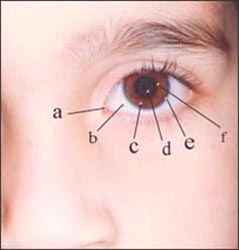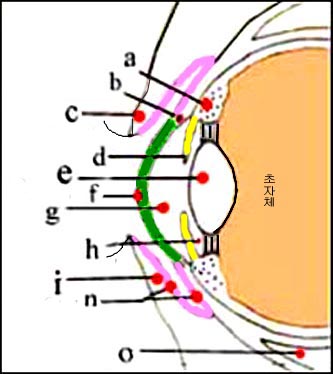각막 외상 Corneal trauma
각막 외상의 원인

사진 55. a-비루관 입구(코 눈물관 입구), b-공막, c-홍채, d-동공, e-연, f-각막
Copyright ⓒ 2011 John Sangwon Lee, M.D., FAAP

그림 56. 초록색 부분이 각막이다
a-모양체(섬모체), b-쉴렘관, c-위 눈꺼풀, d-홍채, e-수정체(렌즈), f-각막, g-전방, h-후방, i-아래 눈꺼풀, n-결막, o-안구 근육(안구 하직근). Copyright ⓒ 2011 John Sangwon Lee, M.D., FAAP
- 이미 각막 이물 제목으로 각막 외상에 관해 언급했다.
- 여기서 각막 외상에 관해 더 설명한다.
- 티끌이나 작은 물체 등이 각막에 세게 튀어 들어갈 때 각막 표면 또는 각막 전 층에 상처가 생길 수 있다.
- 각막 표면이 손톱, 종이, 풀잎, 콘택트 렌즈 등으로 긁히거나 찢어질 수 있고 살짝 벗겨질 수 있다.
- 살짝 긁힌 각막 표면 상처를 각막 찰과상이라고 한다. p. 00 각막 이물 참조.
- 이와 같이 각막에 생긴 상처를 통틀어 각막 외상이라고 한다.
- 여러 종류의 각막 외상 중 각막 찰과상이 가장 흔하다.
각막 외상의 증상 징후
- 원인, 외상의 정도, 합병증의 유무 등에 따라 증상 징후가 다르다.
- 각막 외상을 입은 눈은 몹시 아플 수 있다.
- 햇빛이나 밝은 전등 불빛이 눈에 비치면 눈이 몹시 부셔서 뜰 수 없다.
- 눈물이 많이 나고 눈이 빨갛게 된다.
- 각막 외상의 정도에 따라 시력이 나빠질 수 있다.
- 어려서 말로 잘 표현할 줄 모르는 영유아들이 자신의 옷깃이나 손톱 등으로 자신의 각막에 외상을 입힐 수 있다.
- 눈이 갑자기 빨갛고, 눈을 잘 뜨지 못하며 마구 보챌 때는 각막 외상 등이 있는지 살펴보아야 한다.
각막 외상의 진단
- 병력, 증상 징후와 진찰소견 등을 종합해서 각막 외상을 진단할 수 있다.
- 각막 외상을 입었을 때 말로 잘 표현할 수 있고 “무엇으로 눈을 다친 것 같다”고 말할 때도 있다.
- 때로는 부모도 각막에 난 상처를 육안으로 볼 수 있다.
- 각막 외상을 입었다고 의심되면 눈에 안대를 대고 안과 전문의나 병원 응급실로 급히 데리고 가야 한다.
- 단골 소아청소년과 전문의의 진단을 받고 안과 전문의에게 의뢰해 치료 할 수 있다.
- 각막 외상이 있는 눈에 국소 마취 안약을 넣고 특수 안과 의료기로 눈을 들여다보고 진단한다.
- 헐피스바이러스(헤르페스 바이러스) 감염으로 헐피스 바이러스 각막염이 생길 수 있다. 각막 외상과 헐피스 바이러스 각막염의 증상 징후과 비슷할 때도 있다. 이 두 병을 감별 진단해야 한다.
각막 외상의 치료
- 각막이 외상을 입었다고 의심되면 병원 응급실이나 안과로 곧 데리고 가서 진단 치료를 받아야 한다.
- 눈이 아프면 국소 마취 안약 및, 또는 타이레놀 등으로 진통 치료를 해 준다.
- 외상을 입은 각막에 항생제 안연고를 바르고 안대를 대어 그 눈이 편히 쉬도록 하고 감염을 예방한다.
- 심한 각막 열상 등은 입원해서 찢어진 각막 열상을 꿰매 주는 치료를 받아야 한다.
Corneal trauma 각막 외상
Causes of corneal trauma

Photo 55. a-nasal duct (inlet of nasal lacrimal duct), b-sclera, c-iris, d-pupil, e-soft, f-cornea Copyright ⓒ 2011 John Sangwon Lee, M.D., FAAP

Figure 56. The green area is the cornea a-ciliary body (ciliary body), b-Schlem’s canal, c-upper eyelid, d-iris, e-lens (lens), f-cornea, g-anterior, h-posterior, i-lower eyelid, n-conjunctiva, o – ocular muscle (inferior rectus ocular muscle). Copyright ⓒ 2011 John Sangwon Lee, M.D., FAAP
• We have already mentioned corneal trauma under the heading Corneal Foreign Body. • More about corneal trauma here.
• When a particle or a small object hits the cornea hard, the corneal surface or the entire cornea may be damaged.
• The surface of the cornea may be scratched, torn, and slightly peeled off with nails, paper, blades of grass, contact lenses, etc.
• A scratch on the corneal surface that is slightly scratched is called a corneal abrasion. p. 00 See Corneal Foreign Body.
• These wounds on the cornea are collectively referred to as corneal trauma.
• Corneal abrasions are the most common of several types of corneal trauma.
Symptoms, signs of corneal trauma
• Symptoms and signs differ depending on the cause, degree of trauma, and the presence or absence of complications.
• An eye with corneal trauma can be very painful.
• When sunlight or bright light hits your eyes, your eyes are so dazzling that you cannot open them.
• I have a lot of tears and my eyes become red.
• Depending on the degree of corneal trauma, vision may deteriorate. • Infants and young children who cannot express themselves in words can injure their corneas with their collars or fingernails.
• If your eyes suddenly turn red, you can’t open your eyes, and your eyes are bloated, you should check for corneal trauma.
Diagnosis of corneal trauma
• Corneal trauma can be diagnosed by synthesizing the medical history, symptom signs, and examination findings.
• When you have a corneal trauma, you can verbalize it and sometimes say, “I think something hurt my eye.”
• Sometimes even parents can see the corneal scar.
• If you suspect you have suffered corneal trauma, you should put an eye patch on your eye and take it to an ophthalmologist or hospital emergency room immediately.
• You can receive a diagnosis from a regular pediatrician and refer to an ophthalmologist for treatment.
• Apply local anesthetic eye drops to the eye with corneal trauma and examine the eye with a special ophthalmic device for diagnosis.
• Herpesvirus (herpesvirus) infection can cause herpesvirus keratitis.
Symptoms of corneal trauma and herpesvirus keratitis are sometimes similar. These two diseases must be differentiated.
Treatment of corneal trauma
• If you suspect that your cornea has been traumatized, you should immediately take it to the hospital emergency room or ophthalmologist for diagnostic treatment.
• If your eyes hurt, use local anesthetic eye drops or Tylenol for pain relief.
• Apply antibiotic eye ointment to the traumatized cornea and place an eye patch so that the eye can rest and prevent infection.
• Severe corneal lacerations, etc., require hospitalization and treatment to sew the torn corneal lacerations.
출처 및 참조문헌
- www.drleepediatrics.com 제 6권 신생아 성장 발육 육아 질병
-
www.drleepediatrics.com제7권 소아청소년 감염병
- www.drleepediatrics.com제8권 소아청소년 호흡기 질환
- www.drleepediatrics.com제9권 소아청소년 소화기 질환
- www.drleepediatrics.com제10권. 소아청소년 신장 비뇨 생식기 질환
- www.drleepediatrics.com제11권. 소아청소년 심장 혈관계 질환
- www.drleepediatrics.com제12권. 소아청소년 신경 정신 질환, 행동 수면 문제
- www.drleepediatrics.com제13권. 소아청소년 혈액, 림프, 종양 질환
- www.drleepediatrics.com제14권. 소아청소년 내분비, 유전, 염색체, 대사, 희귀병
- www.drleepediatrics.com제15권. 소아청소년 알레르기, 자가 면역질환
- www.drleepediatrics.com제17권. 소아청소년 피부 질환
- www.drleepediatrics.com제18권. 소아청소년 이비인후(귀 코 인두 후두) 질환
- www.drleepediatrics.com제19권. 소아청소년 안과 (눈)질환
- Red book 29th-31st edition 2021
- Nelson Text Book of Pediatrics 19th — 21st Edition
- The Johns Hopkins Hospital, The Harriet Lane Handbook, 22nd edition
- 결막 이물
- 눈의 이물
- 각막 이물
- 안구 속에 들어간 이물
-
Childhood Emergencies in the Office, Hospital and Community, American Academy of Pediatrics
-
Emergency Medical Service for Children, By Ross Lab. May 1989. p.10
-
Emergency care, Harvey grant, and Robert Murray
-
Emergency Care Transportation of Sick and Injured American Academy of Orthopaedic Surgeons
-
Emergency Pediatrics A Guide to Ambulatory Care, Roger M. Barkin, Peter Rosen
-
Immediate care of the acutely ill and injured, Hugh E. Stephenson, Jr
-
The Critically Ill Child, Diagnosis and Management, Edited by Clement A. Smith
-
Emergency Medical Services for Children: The Role of the Primary Care Provider, America Academy of Pediatrics
-
Quick Reference To Pediatric Emergencies, Delmer J. Pascoe, M.D., Moses Grossman, M.D. with 26 contributors
-
Manual of Emergency Care
-
응급환자관리 정담미디어
-
소아가정간호백과–부모도 반의사가 되어야 한다, 이상원
-
Neonatal Resuscitation American heart Association
-
Neonatology Jeffrey J.Pomerance, C. Joan Richardson
-
Pediatric Resuscitation Pediatric Clinics of North America, Stephen M. Schexnayder, M.D.
-
Pediatric Critical Care, Pediatric Clinics of North America, James P. Orlowski, M.D.
-
Preparation for Birth. Beverly Savage and Dianna Smith
- Infectious disease of children, Saul Krugman, Samuel L Katz, Ann A. Gershon, Catherine Wilfert
-
The Harriet Lane Handbook 19th Edition
-
소아과학 대한교과서
-
제1권 소아청소년 응급의료 참조문헌과 출처
-
Other
Copyright ⓒ 2015 John Sangwon Lee, MD., FAAP
“부모도 반의사가 되어야 한다”-내용은 여러분들의 의사로부터 얻은 정보와 진료를 대신할 수 없습니다.
“The information contained in this publication should not be used as a substitute for the medical care and advice of your doctor. There may be variations in treatment that your doctor may recommend based on individual facts and circumstances. “Parental education is the best medicine.”